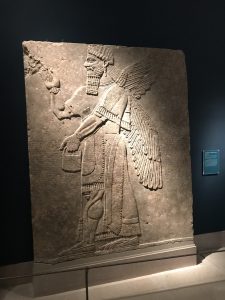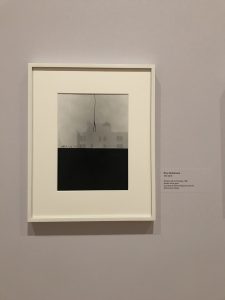While visiting the Brooklyn Museum, there were many exhibits that struck me as interesting. There were many ancient world pieces from many different time periods as well as beautiful cultures being represented with history. One piece that stood out from me was a relief gallery of King Ashur-nasir-pal II’s palace from the Neo-Assyrian time period. When you walk around, you spot about 12 giant wall panels that once used to reside in his palace. I have attached the image of the one that caught my eye. Titled “Winged Genie Wearing Fancy Bracelets,” it exhibits exactly that. With first glance, you can determine many details of this grand piece of art. It is essentially a large piece of carved out alabaster that gives it it’s 3D shapes and edges. They were all once brightly painted but now exist no colors except a dusty beige tone of the material it’s made out of. The subject is a genie wearing bracelets containing rosettes. With these panels, he intended to show legitimacy to his kingdom and verify his power. These symbols proved that he was in accordance with the gods and these genies are protectors, depicting his great divine power. You can see the three rosettes on the subject’s headband and two wristbands. They show worship to the goddess Ishtar. This panel includes straight alignment and many straight lines of small details such as the curls in the beard and feathers in the wings. It is repetitive and in-line. Furthermore, realistic details are carved out of the genie such as his muscles and even his palm lines. I would estimate the panel to stand about seven feet tall so it seems that the subject is scaled to real life sizing.
Across the center of the piece, you can see scripture embedded into the alabaster. Upon deeper reading, it becomes evident that the scripture is written in cuneiform and the language is in Akkadian. It tells stories about the king’s military victories, rules of his empire and historical context of Kalhu and his palace.
I chose this piece because it seemed surreal that I was standing among such sturdy and lasting pieces of a palace. It had historical context and tells a story among them. I could only imagine what they had looked like in their time with appropriate paint.
A second exhibit that was really interesting was Soul of A Nation. The piece I chose to write about is titled “Shade cord and window”, 1961 by Roy DeCarava. It is a gelatin silver print. What you see in this picture is a single “shade cord” through what looks like a window, and a background of one gray building. The photo is contrasted into two halves, the bottom half being completely black.
With a critical lens and context to the exhibit, I can predict that the image is supposed to reflect Black history. A second meaning behind the shade cord can be that it resembles that of a noose, in the city. Although it can be considered more modern in 1961 (represented through a city building), the noose can symbolize racial division that has been and still is occurring. The window can represent people looking through their window from far away and speculating as it happens, many things.
Through formal analysis, you can determine this is supposed to be a simple, straight forward message. There are 3 colors; black, white and gray and possible mixed in different tones. About half of the image is cut in black so you focus on just the upper half of the photo. The artist could have made whatever you see the whole image but focusing on a smaller zoned in area can be more effective. The single building is in a blurry gray in attempt to show the building is lingering in the far background, more so in the distance while the subject of the piece, the only other thing in black: the shade cord. We exhibit straight lines and an image in gray scale here.
I chose this because it caught my eye as soon as I glanced over. It seemed very simple but the message was empowering as I understood it to be. While recognizing the correct historical significance and context, many vague and simplistic works of art can expand to something greater to the eye.



